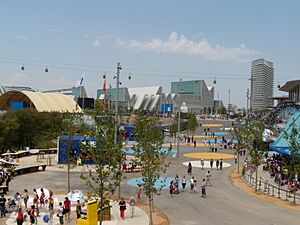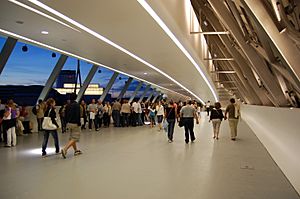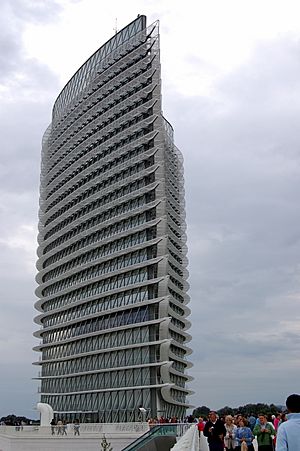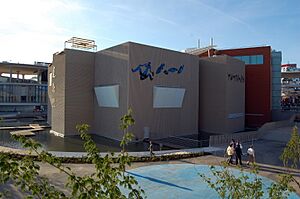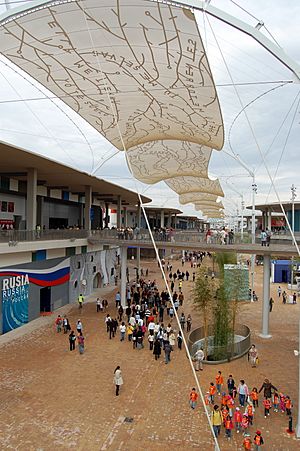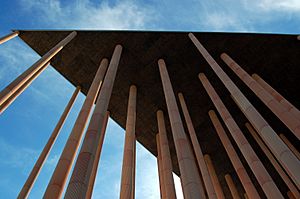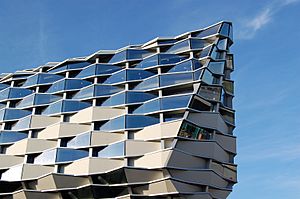Expo 2008 facts for kids
Quick facts for kids 2008 Zaragoza |
|
|---|---|
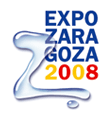
Expo 2008 official logo
|
|
| Overview | |
| BIE-class | Specialized exposition |
| Category | International Recognized Exhibition |
| Name | Expo 2008 |
| Area | 25 hectares (62 acres) |
| Visitors | 5,650,941 |
| Mascot | Fluvi |
| Participant(s) | |
| Countries | 104 |
| Organizations | 21 |
| Location | |
| Country | Spain |
| City | Zaragoza |
| Coordinates | 41°40′8.58″N 0°54′10.27″W / 41.6690500°N 0.9028528°W |
| Timeline | |
| Bidding | June 2003 |
| Awarded | 16 December 2004 |
| Opening | 14 June 2008 |
| Closure | 14 September 2008 |
| Specialized expositions | |
| Previous | Expo '98 in Lisbon |
| Next | Expo 2012 in Yeosu |
| Universal expositions | |
| Previous | Expo 2005 in Aichi |
| Next | Expo 2010 in Shanghai |
| Horticultural expositions | |
| Previous | Royal Flora Ratchaphruek in Chiang Mai |
| Next | Floriade 2012 in Venlo |
Expo 2008 was a big international event held in Zaragoza, Spain. It took place from June 14 to September 14, 2008. The main idea or "theme" of the Expo was "Water and Sustainable Development." This means they focused on how important water is and how we can use it wisely without harming the planet.
The Expo was set up along the Ebro river. It was organized by the Bureau International des Expositions (BIE). This group is in charge of approving all the major World's Fairs.
Zaragoza is a large city in Spain. It was chosen to host Expo 2008 on December 16, 2004. It won against other cities like Thessaloniki in Greece and Trieste in Italy.
Some of the most famous buildings at the Expo were the Water Tower, the Bridge Pavilion, and the river aquarium. Many events happened there, including a daily parade by Cirque du Soleil called The Awakening of the Serpent.
Besides countries, many non-government groups and private companies also joined Expo 2008. They all shared ideas about water and how to use it in a sustainable way.
Contents
Exploring the Expo: Buildings and Exhibits
Special Pavilions: Amazing Buildings
Bridge Pavilion: A Unique Entrance
The Bridge Pavilion was one of the most eye-catching buildings at Expo 2008. It was designed by a famous architect named Zaha Hadid. The building looked like a gladiolus flower, which is a type of plant, opening and closing.
This pavilion connected the La Almozara neighborhood to the Expo site. It stretched over a central island in the Ebro river. Inside, the pavilion hosted an exhibit called Water – a unique resource. This exhibit taught visitors that water is a basic human right. It also showed how water is special and how we can manage it better.
Water Tower: A Giant Drop of Water
The Water Tower was another very important building at Expo 2008. It was designed by Enrique de Teresa. The tower was 76 meters (about 250 feet) tall. It had 10,400 square meters (about 112,000 square feet) of space that people could visit.
At the very top, there was a bar with amazing views of Zaragoza. Inside the tower, there was a huge 23-meter (about 75 feet) tall sculpture called Splash. This sculpture looked like a big splash of water. It was meant to show how life came to our planet. The Water Tower also had an exhibit called Water for life. This exhibit used videos and lights to share its message.
River Aquarium: Life from Rivers Around the World
This special building is now the biggest freshwater aquarium in Europe. It stayed open even after the Expo finished. It has over 300 types of animals from rivers all over the world. You can see them in 60 different tanks or terrariums.
The aquarium shows animals from famous rivers like:
- The Nile: Here you can see animals from Africa's great lakes. There are also crocodiles and exhibits about the Mediterranean and Red Sea.
- The Mekong: This section has animals from the Himalayas and plants from the river's lower parts.
- The Amazon river: This area is split into three parts. One part shows the Amazon jungle with its coconut trees. Another part is about the Amazon forest. The third part is a mangrove swamp with an exhibit about the Atlantic Ocean.
- The Murray-Darling river: This exhibit starts in flooded areas and goes through deserts. It ends with a video about birds.
- The Ebro: This river, which flows through Zaragoza, is shown in two areas. One is a mountain cave, and the other is the river's main path. There is also an exhibit about the Mediterranean Sea.
- The "World River": This part shows what the Earth might have looked like long ago. It imagines a time when all the continents were one big island surrounded by ocean.
Thematic Squares: Interactive Experiences
Thirst: Playing with Light and Sound
This special area used mirrors, videos, and a mix of light and sound. It created cool optical illusions for visitors. The square was about 46.7 meters (about 153 feet) wide. It covered a total area of 1,640 square meters (about 17,650 square feet).
Igloo of Salt: A Cool and Smart Building
This unique square was designed by Cloud 9 / Enric Ruiz-Geli. It looked like a mysterious building. It was an inflatable structure covered with salt. The salt reflected the sun's rays during the day. At night, it lit up as if it had stored energy.
This area was built to be very sustainable. For example, it avoided using certain plastics and tropical wood. The building's roof had three layers of a special material called EFTE. This material helped keep the inside cool. It meant that less air conditioning was needed. This made the building more eco-friendly and cheaper to run.
Cities of Water: Water in Urban Life
This square had no walls, so you could see inside from the outside. The exhibit was all about water as a "city resource." It showed how water helps improve the quality of life in cities.
Extreme Water: Waves and Risks
This square looked like a wave breaking on a beach. It had two parts. The first part was a "sensory area" with 120 moving seats. Videos were shown here. The second part was an "ideas area" with interactive displays. It had images and texts about water and its dangers.
Oikos, Water and Energy: Power from Water
This exhibit taught visitors about how we can get energy from water.
This special square showed how political borders can affect how water is managed around the world.
Aquatic Inspirations: A Daily Show
This square hosted a show called El hombre vertiente. It was created by Pichón Baldinu from Argentina. This show was performed six times every day.
Participant Pavilions: Countries and Communities
Country Pavilions: A Global Gathering
More than 100 countries took part in Expo 2008. Many companies and non-government organizations (NGOs) also joined. The countries were grouped into eight large buildings. They were also divided into five different eco-geographical areas. These areas included:
- Islands and Coasts
- Oasis
- Ice and snow
- Temperate Forests
- Tropical Rainforests
- Mountains and High Plains
- Grasslands, Steppes and Savannahs
- Rivers and Flat plains
Here is a list of the 104 countries that participated:
The 17 regions of Spain and two cities, Ceuta and Melilla, also took part. The United Nations and the European Union were also participants.
Spain and the region of Aragon had their own special pavilions as the hosts. The Spain Pavilion was designed by Patxi Mangado. The Aragon Pavilion looked like local basket weaving and was designed by Daniel Olano.
Citizen's Initiative Pavilion: A Symbol of Hope
This pavilion looked like a beacon, which is a light that guides ships. It was a "symbol of hope for the future of water in our world." It showed the energy and ideas of everyday people and non-governmental groups. The Beacon was located near the Bridge Pavilion entrance.
Philippines Wins Gold Prize
On September 19, 2008, the Philippines won the "Gold Prize." This was the highest award for a country at the Expo. The award recognized the beautiful design of the Philippine pavilion. It had 1,000 crystal-like bubble sands inside and out. The pavilion also showed how important its theme was to "Water and Sustainable Development."
Tourism Secretary Joseph Ace Durano said that the award was well-deserved. He explained that the country's rich water life was shown through the creativity of its people. While other countries used modern technology, the Philippines chose to highlight community-based practices. These included natural land watering, water fun, and protecting ocean resources. The Philippine pavilion also had fun events like the meeting of the two mascots, Fluvi and Filippo.
Shows and Entertainment
Expo 2008 had a huge program of shows that lasted for 93 days. There were more than 3,400 performances by over 350 different groups and artists.
Three main shows were featured at the Expo site:
Iceberg: A Giant Sculpture on the River
This show was supposed to be part of the Opening Ceremony. However, the Ebro river flooded a few days before, so plans had to change. The set for the show was in the middle of the river. Even so, the show was performed every night starting on June 20. It featured a giant iceberg with a tiny human figure.
El hombre vertiente: The Leaning Man
This show was created by Pichón Baldinu from Argentina. It became the artistic part of the Opening Ceremony on June 13, 2008, instead of "Iceberg." It was performed six times a day at the Aquatic Inspirations square.
The Awakening of the Serpent: A Daily Parade
This water-themed parade happened every day at the Expo site. It was called "The Awakening of the Serpent" and moved around the grounds. The famous Canadian group Cirque du Soleil was part of the parade. They brought their amazing acrobats, actors, gymnasts, singers, and musicians.
Music Stars at the Expo
The Expo 2008 officially opened with a concert by Bob Dylan. He was the official artist for the event. Many other famous American artists also performed on the evening stage. These included Patti Smith, Robert Cray, Keb Mo, Ruben Blades, and Gloria Estefan. The Canadian artist Diana Krall also performed. A concert by Philip Glass closed Expo 2008.
Fluvi: The Expo Mascot

The mascot for Expo 2008 was Fluvi. Fluvi was a small male drop of water.
Fluvi's best friend was Ica, who was the smallest drop of water. Together with Nico and Laurita, they fought against pollution. The bad guys were Sec and Raspa, known as the evil Negas.
The country of Qatar even made a special postage stamp to celebrate Expo Zaragoza 2008. It showed Fluvi on it.
After the Expo: A New City Area
The Expo site and its buildings were designed to be used after the event. The idea was to turn the area into a new part of the city. Many buildings were planned to be rented or given to different groups. For example, the Aragon Pavilion was set to become the main office for a regional government department.
The famous buildings like the Water Tower and the Bridge Pavilion were expected to be bought by local financial groups. The Spanish Pavilion was planned to be used by the University of Zaragoza for a new school of architecture.
The international pavilions were going to be changed into offices. This would make the site a major business park in Zaragoza. The area was also planned to have fun places and restaurants.
A large part of the site was also expected to be used for shops and a science park for businesses. The Aquarium, being the largest freshwater aquarium in Europe, has continued to operate since the Expo.
See also
 In Spanish: Exposición Especializada de Zaragoza para niños
In Spanish: Exposición Especializada de Zaragoza para niños


